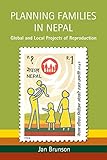Planning Families in Nepal : Global and Local Projects of Reproduction / Jan Brunson.
Material type: TextPublisher: New Brunswick, NJ : Rutgers University Press, [2016]Copyright date: ©2016Description: 1 online resource (168 p.) : 11 figures, 1 tableContent type:
TextPublisher: New Brunswick, NJ : Rutgers University Press, [2016]Copyright date: ©2016Description: 1 online resource (168 p.) : 11 figures, 1 tableContent type: - 9780813578620
- 9780813578644
- 363.96095496
- HQ766.5.N37 B78 2016
- HQ766.5.N37
- online - DeGruyter
- Issued also in print.
| Item type | Current library | Call number | URL | Status | Notes | Barcode | |
|---|---|---|---|---|---|---|---|
 eBook
eBook
|
Biblioteca "Angelicum" Pont. Univ. S.Tommaso d'Aquino Nuvola online | online - DeGruyter (Browse shelf(Opens below)) | Online access | Not for loan (Accesso limitato) | Accesso per gli utenti autorizzati / Access for authorized users | (dgr)9780813578644 |
Frontmatter -- CONTENTS -- Acknowledgments -- Note on Transliteration, Transcription, and Pronunciation -- Introduction: Life in Motion -- 1. Intersections: Gender, Class, and Caste in Nepal -- 2. Like a Potter's Wheel: From Daughters to Mothers-in-Law -- 3. The Elusive Small, Happy Family -- 4. Son Preference and the Preferences of Sons -- 5. Conclusion: Projects of Reproduction -- Appendix A: Caste Hierarchy in Nepal -- Appendix B: Trends in Contraceptive Use in Nepal -- Notes -- References -- Index -- ABOUT THE AUTHOR
restricted access online access with authorization star
http://purl.org/coar/access_right/c_16ec
Based on almost a decade of research in the Kathmandu Valley, Planning Families in Nepal offers a compelling account of Hindu Nepali women as they face conflicting global and local ideals regarding family planning. Promoting a two-child norm, global family planning programs have disseminated the slogan, "A small family is a happy family," throughout the global South. Jan Brunson examines how two generations of Hindu Nepali women negotiate this global message of a two-child family and a more local need to produce a son. Brunson explains that while women did not prefer sons to daughters, they recognized that in the dominant patrilocal family system, their daughters would eventually marry and be lost to other households. As a result, despite recent increases in educational and career opportunities for daughters, mothers still hoped for a son who would bring a daughter-in-law into the family and care for his aging parents. Mothers worried about whether their modern, rebellious sons would fulfill their filial duties, but ultimately those sons demonstrated an enduring commitment to living with their aging parents. In the context of rapid social change related to national politics as well as globalization-a constant influx of new music, clothes, gadgets, and even governments-the sons viewed the multigenerational family as a refuge. Throughout Planning Families in Nepal, Brunson raises important questions about the notion of "planning" when applied to family formation, arguing that reproduction is better understood as a set of local and global ideals that involve actors with desires and actions with constraints, wrought with delays, stalling, and improvisation.
Issued also in print.
Mode of access: Internet via World Wide Web.
In English.
Description based on online resource; title from PDF title page (publisher's Web site, viewed 30. Aug 2021)


